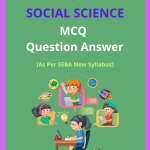SEBA Class 8 Social Science MCQ Chapter 21 The Revolt of 1857 Solutions in English Medium, Class 8 Social Science Multiple Choice Question Answer to each chapter is provided in the list so that you can easily browse throughout different chapters SEBA Class 8 Social Science MCQ Chapter 21 The Revolt of 1857 Question Answer and select need one.
SEBA Class 8 Social Science MCQ Chapter 21 The Revolt of 1857
Also, you can read the SCERT book online in these sections SEBA Class 8 Social Science Objective Type Solutions by Expert Teachers as per SCERT (CBSE) Book guidelines. These solutions are part of SCERT All Subject Solutions. Here we have given Assam SEBA Class 8 Social Science MCQ Solutions for All Subject, You can practice these here.
The Revolt of 1857
Chapter – 21
| MCQ |
1. Which of the following was NOT a consequence of the British conquest of India?
(a) The British East India Company became the de facto ruler of India.
(b) India was divided into different administrative units.
(c) The Indian economy was transformed into a colonial economy.
(d) India became a self-sufficient nation.
Answer: (d) India became a self-sufficient nation.
2. What was the Permanent Settlement of Bengal?
(a) A system of land revenue collection introduced by the British.
(b) A permanent peace treaty between the British and Indian rulers.
(c) A permanent ban on Indian industries by the British.
(d) A permanent settlement of British soldiers in India.
Answer: (a) A system of land revenue collection introduced by the British.
3. Which of the following was a major impact of the Permanent Settlement of Bengal?
(a) It led to the rise of a powerful zamindari class.
(b) It improved the condition of the Indian peasantry.
(c) It strengthened the Indian economy.
(d) It led to the decline of British power in India.
Answer: (a) It led to the rise of a powerful zamindari class.
4. What was the Mahalwari system of land revenue collection?
(a) A system where land revenue was collected from individual farmers.
(b) A system where land revenue was collected from entire villages.
(c) A system where land revenue was collected from zamindars.
(d) A system where land revenue was collected from the British government.
Answer: (b) A system where land revenue was collected from entire villages.
5. Which of the following was NOT a consequence of the British land revenue systems?
(a) The exploitation of Indian farmers.
(b) The decline of Indian agriculture.
(c) The rise of rural indebtedness.
(d) The improvement of the Indian economy.
Answer: (d) The improvement of the Indian economy.
6. What was the Ryotwari system of land revenue collection?
(a) A system where land revenue was collected from individual farmers.
(b) A system where land revenue was collected from entire villages.
(c) A system where land revenue was collected from zamindars.
(d) A system where land revenue was collected from the British government.
Answer: (a) A system where land revenue was collected from individual farmers.
7. Which British Governor-General introduced the Permanent Settlement of Bengal?
(a) Lord Cornwallis.
(b) Warren Hastings.
(c) Lord William Bentinck.
(d) Lord Dalhousie.
Answer: (a) Lord Cornwallis.
8. Which British Governor-General introduced the Mahalwari system?
(a) Lord Cornwallis.
(b) Warren Hastings.
(c) Lord William Bentinck.
(d) Lord Dalhousie.
Answer: (a) Lord Cornwallis.
9. Which British Governor-General introduced the Ryotwari system?
(a) Lord Cornwallis.
(b) Warren Hastings.
(c) Lord William Bentinck.
(d) Lord Dalhousie.
Answer: (c) Lord William Bentinck.
10. Which of the following best describes the impact of British land revenue systems on India?
(a) They led to the economic prosperity of India.
(b) They led to the exploitation and impoverishment of the Indian peasantry.
(c) They had no significant impact on India.
(d) They led to the rise of a powerful Indian middle class.
Answer: (b) They led to the exploitation and impoverishment of the Indian peasantry.
11. Who was the first Viceroy of India?
(a) Lord Canning.
(b) Lord Dalhousie.
(c) Lord Curzon.
(d) Lord Lytton.
Answer: (a) Lord Canning.
12. Which event is commonly considered the beginning of the Revolt of 1857?
(a) The mutiny of the Bengal Army.
(b) The uprising in Meerut.
(c) The capture of Delhi.
(d) The outbreak of a famine.
Answer: (b) The uprising in Meerut.
13. Who was the last Mughal Emperor during the Revolt of 1857?
(a) Akbar II.
(b) Bahadur Shah II.
(c) Aurangzeb.
(d) Shah Alam II.
Answer: (b) Bahadur Shah II.
14. Which of the following was NOT a cause of the Revolt of 1857?
(a) Military grievances.
(b) Social and religious reforms.
(c) Economic policies.
(d) The introduction of railways.
Answer: (d) The introduction of railways.
15. Who was the prominent leader of the revolt in Kanpur?
(a) Rani Lakshmibai.
(b) Begum Hazrat Mahal.
(c) Nana Saheb.
(d) Mangal Pandey.
Answer: (c) Nana Saheb.

Hi! my Name is Parimal Roy. I have completed my Bachelor’s degree in Philosophy (B.A.) from Silapathar General College. Currently, I am working as an HR Manager at Dev Library. It is a website that provides study materials for students from Class 3 to 12, including SCERT and NCERT notes. It also offers resources for BA, B.Com, B.Sc, and Computer Science, along with postgraduate notes. Besides study materials, the website has novels, eBooks, health and finance articles, biographies, quotes, and more.




